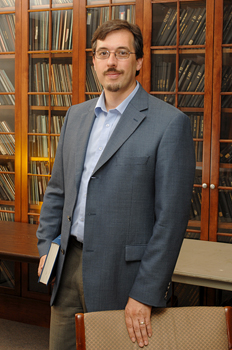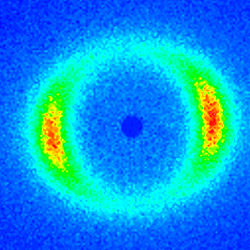
Neutron scattering is a nanoscale measurement technique that is complementary to X-ray and light scattering as a means to probe the structure of materials at the molecular, nano- and meso-scales.
UD won the award as part of an open competition sponsored by the NIST Center for Neutron Research (NCNR) in Gaithersburg, Md.
Neutron beams have become an indispensable research tool in materials science, biotechnology, chemistry, engineering and physics because of their ability to image materials and structures non-destructively at atomic and molecular scales. Neutrons can "see" the structure and motions of very large biological molecules, such as proteins, to better understand their function and can lead to the development of new drug therapies and improved vaccines.
The new UD center will explore and develop new areas of neutron scattering science, with emphasis on strengths in complex fluids, macromolecular science and condensed matter physics.
“The University of Delaware has been a strong supporter and user of neutron scattering instrumentation and research,” said Norman Wagner, Alvin B. and Julia O. Stiles Professor of Chemical Engineering and chairperson of the Department of Chemical Engineering. “There is a synergy between UD and NIST. This award will take that synergy to the next level as UD helps to create the future of neutron scattering as a measurement tool.”
Wagner added that “this is an exciting time” for neutron research. “There is huge demand for neutron scattering facility usage, one which far outstrips our national capacity,” he said, noting that the federal government is making important investments in the nation's infrastructure for neutron science. “It is great that Delaware will be a key part of that,” he said.
Wagner said UD is a leader in the field of neutron scattering, particularly in small-angle scattering research, and the partnership will enhance the nation's small-angle neutron scattering capabilities.
Small-angle neutron scattering is a powerful probe of molecular and nanoscale structure, supramolecular order and dynamics, and can be used to monitor chemical and field-induced transformations, Wagner said, adding that because the technique requires a high-flux neutron source, measurements are carried out at large national facilities. There are only five such facilities in the U.S., including the NCNR in Gaithersburg, Md..
He said the award will further advance UD's world-recognized expertise in small-angle neutron scattering. This research is carried out mainly in UD's departments of chemical engineering and materials science and engineering and in their long-standing scientific collaborations with NIST.
The goals of the cooperative agreement include: the application of small-angle neutron scattering instrumentation, the exploration of new scientific applications of neutron scattering measurements, the development of new instrumentation and the development of new educational and training materials for use at UD, NIST and more broadly in support of the national neutron user community.
The project will include significant collaborative research with NIST scientists and assisting visiting researchers at the NCNR, Wagner said, adding that the partnership will help to develop novel experimental instrumentation of value to the broader research community. The educational and outreach activities of the UD faculty will be leveraged to enhance educational activities of the national center to advance the use of neutrons by university and industrial scientists, he said.

Also, UD will hire doctoral candidates and postdoctoral researchers to work on the University campus on scientific projects using neutron scattering, thereby helping drive the design of future instrumentation.
Part of the project provides for the transfer of educational and scientific developments from UD for application in industry.
Wagner said the research using neutron scattering will have direct engineering and societal impact in a broad range of applications, from health care to water purification.
It will provide for the creation of new nanostructure building blocks for functional nanodevices, such as photonic materials, sensors and drug delivery agents, and will improve the efficacy of nanocomposite protective materials, such as the STF-Armor body armor developed by UD in cooperation with the U.S. Army Research Laboratory.
The research will assist in the development of new membranes for applications in fuel cells, batteries and water purification membranes; engineered nanomaterials for wound healing and tissue repair; and new catalysts for improved energy production. Also, it will improve the processing and efficacy of pharmaceuticals and personal care products and provide for the development of improved coatings and adhesives.
Wagner and Eric W. Kaler were principal investigators in the competition proposal that led to the award. Kaler served as dean of UD's College of Engineering since 2000 but has stepped down effective Oct. 1 to accept a position as provost and senior vice president for academic affairs at Stony Brook University.
Co-principal investigators are Thomas H. Epps III, assistant professor of chemical engineering; Raul Lobo, professor of chemical engineering; Kristi Kiick, associate professor of materials science engineering; and Darrin Pochan, associate professor of materials science engineering. Also involved in the project is Millicent Sullivan, assistant professor of chemical engineering.
For more information, see the Web site [www.cns.che.udel.edu].
Article by Neil Thomas

